Arguably, the best second-generation Z28s were the first – and the last.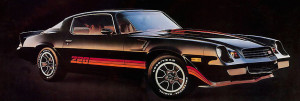
While the Z’s sister car – Pontiac’s Trans-Am – rose to the occasion several times during the lowest points of the middle-late 1970s (examples include the ’73-74 SD-455, the most powerful Trans-Am ever made – and made at a moment when power – real power – was becoming hard to find anywhere; also the ’77-79 400, 4-speed, WS-6 Trans-Ams, which rivaled the L-82 Corvette for acceleration – and beat it when it came to cornering) the Z literally disappeared for two years (1975-’76) and when it came back in the summer of ’77 it was – literally – a stripe and decal job.
The 77 1/2 Z had the same LM-1 350 4-BBL V-8 that could be ordered in other Camaros – in other Chevys. Malibus and Novas. There were no special performance parts internally. Just a “Z28” sticker on the air cleaner lid.
Its rated 170 hp was weak even by the standards of the late ’70s (the ’77 Trans-Am could be ordered with a 200 hp 400 – upped to 220 in ’78).
Straight line performance was predictably mediocre. Most period tests reported a 0-60 time around 8 seconds – with the quarter-mile run taking about 17 seconds.
Chevy could have stolen much of Pontiac’s thunder by offering the Corvette’s optionally available L-82 350 (which was a genuine high-performance 350) as the revivified ’77 1/2 Z28’s standard engine. The L-82 was still the same basic engine that Chevy had installed as standard equipment in the ’70 LT-1 Corvette – and also the ’70 1/2 Z28. It still had the same heavy duty 4-bolt main block, the same high-flow cylinder heads – neither of which (unlike the lowly LM-1 350 in the 77 1/2 Z28) were shared with other, low-performance small blocks in the Chevy lineup.
Chevy had de-tuned the L-82 some by ’77, of course. A milder hydraulic cam replaced the LT-1’s aggressive solid lifter stick. And there was a more demure Rochester Quadrajet squatting on top instead of a Holley. But despite all that, the ’77 Corvette L-82 still made 210 hp – 10 more hp more than the ’77 Trans-Am’s optional “T/A 6.6” 400.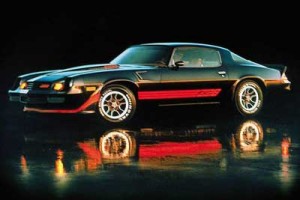
So equipped, the ’77 Z-28 would have leap-frogged to the head of the proverbial class – becoming America’s number-one performance car. And that, perhaps, is why it never happened. The Corvette’s primacy in the GM performance pantheon has always been jealously guarded. Still, they could have gimped the L-82 by say 15 hp and allowed that to happen (It’s what happens today – in 2014. The ’14 Camaro has the same basic V-8 as the ’14 Corvette… just wicked down a little for Camaro duty). Had this been done, the ’77 Corvette would have remained on top – but the ’77 1/2 Z28 would have been much more competitive with its Pontiac sister car.
Chevy did the best it probably could have done under the circumstances to liven up the LM-1. It was fitted with a less restrictive (though not by much) exhaust and – if you ordered the optional automatic – you got the same “CB” TH350 used in the Corvette. It had a higher-stall torque converter and more aggressive shift points. A four-speed manual was standard, of course – but drivetrain-wise, the ’77 1/1 Z-28 was nonetheless virtually identical to a ’75-’76 Type LT ordered with the 350, the manual transmission (and so on).
The focus was on handling now – and the ’77 Z28 did get meaningful upgrades in that department. There were Z-specific leaf springs in the rear – and complementary coils up front – damped by GM Delco shocks designed specifically for the Z. Also higher-rate front and rear anti-roll bars.
But – again – the Z lagged a few steps behind its Pontiac cousin. The ’77 Trans-Am offered aluminum alloy wheels (15×8 inch in ’78) while the Z came only with stamped steel 15×7 Rallye rims. At the Pontiac store, you could also upgrade the T/A’s already excellent Radial Tuned Suspension (RTS) system with an even more excellent suspension (WS-6) which added a high-effort steering box, 15×8 alloy wheels (’78 up) and (in ’79) four-wheel disc brakes. At that time, the only other American cars that offered disc brakes all around were the Corvette – and the Cadillac Seville.
Cosmetically, the TA was also several steps ahead of the Z.
In ’74, the Camaro got what amounted to braces – huge, awkward-looking exposed metal bumpers, fitted to comply with the latest federal requirements.On the 77 1/2 Z28, these were painted body color – which helped.
A little.
Pontiac dealt with the government’s mandate in a much more aesthetically clever way. The bumpers were hidden underneath body color-painted urethane plastic covers, which maintained the clean lines of the car and – at a time when virtually all other cars had exposed bolt-on bumpers – gave the TA an extremely sophisticated look.
And of course, all Trans-Ams had the now-iconic package of exterior enhancements: functional fender vents in the front quarter panels, a chin spoiler to deflect air to the sides, with a set of four smaller spoilers installed ahead of each wheel-well to redirect air there. Also part of the package, the famous “shaker” hood scoop. It had not been functional from the factory since 1972, but could very easily be made functional by the owner. The really important stuff – including the hole in the hood – was already there.
Chevy gave the ’77 1/2 Z28 a hood decal.
But, in 1980, the Z28 began to catch up.
The LM-1 350 was up-rated to 190 hp and the redline raised to 5,000 RPM – possibly achieved as a result of the more efficient exhaust system, which split into dual exhaust aft of the catalytic converter and now used a pair of resonators in place of the previous (more restrictive) transverse muffler that had been stuffed up against the rear axle pumpkin in the ’77 1/2 Z.
There was also a hood scoop. A factory functional hood scoop. The rearward facing “air induction” scoop harkened back to the cowl-induction scoop used in the original (’67-69) Z-28. And unlike the ’73-up Trans-Am’s shaker scoop, the ’80-’81 Z-28’s scoop actually did scoop air. And not only that, it had a throttle-actuated flapper door that opened when the driver floored the accelerator. The second generation Trans-Am last had a scoop like this in 1972 – and never had it again. 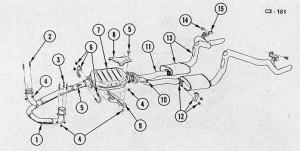
Under the hood, a special (unique to the ’80-81 Zs) air cleaner with an open top and compressible rubber ring that created a tight seal, so that the 350 breathed in cooler, denser outside air (more hp) rather than the less dense air circulating around the hot engine. The air-induction scoop shared its rearward orientation with the TA’s now not-functional scoop – the idea being to duct in air from the low-pressure area at the base of the windshield. Whether it worked better than a forward-facing “ram air” type of scoop is still being debated, but what’s not debatable is that the air-induction scoop was a scoop – and not a decal.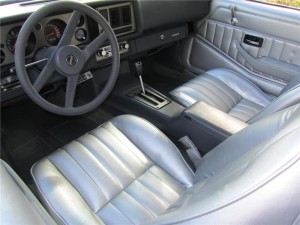
The ‘1980 Z-28 also got a package of aerodynamic enhancements that brought it on par with the Trans-Am. Technically, some elements (such as the fender vents) appeared first in 1978, but the package totale did not come into blossom until 1980. You got the fender slats (new look for the new model year, no longer shark-gill slatted as in ’78-’79, but with a single large opening now), the three-piece front and rear spoiler system and the functional air induction hood scoop (the ’78-79 Z28 had forward-facing, purely decorative scoop).
The larger – and much better designed – Fisher T-Tops were now the only factory-available T-tops. Previously, one could order the smaller Hurst hatches – easily distinguished by their bright chrome trim (and tendency to leak) as opposed to the Fisher tops’ blacked-out trim (and more effective weatherstripping). 
A very attractive billboard-style graphics package that spelled out “Z28” along the flanks of the car (as well a similar decal on the center section of the rear spoiler) completed the look.
But wait, that’s not all.
Finally, Chevy put aluminum wheels on the menu. They were not 15x8s (and would never be) but they were at least alloy – and so a big improvement over the body-colored stamped steel Rallye wheels that were take it or leave it on the ’77 1/2 Z-28.
The Z’s overall appearance had been mightily cleaned up (beginning in ’78) by emulating the body-colored/bumperless look pioneered earlier by Pontiac. And while Pontiac radically changed the face of the TA several times during the mid-late ’70s – going from a pair of round headlights in ’76 to four square ones in ’77 – Chevy took a much more evolutionary approach with the Camaro. The profile of the ’77 (actually, the ’74) was smoothed and rendered in slick body-colored urethane – but never fundamentally changed. Which was good – because it looked great. Chevy succeeded in modernizing what had by then become an aging platform that the public had begun to lose interest in.
It’s more than 30 years in the rearview now, but one wonders what might have been had Chevy slipped the Corvette’s L-82 into the lineup as an option for 1980. It was up to 230 hp now – 10 more hp than the Trans-Am’s top-dog “T/A 6.6 liter” 400 provided. The Chevy small block was also much lighter than the big-inch Pontiac V-8 (technically not a “big block” as all traditional Pontiac V-8s from the 326 to the 455 are the same size externally). An L-82 powered ’80 Z28 would have been stronger – and at least 100 pounds lighter – than a 400-powered Trans Am.
And by 1980, the Trans-Am no longer offered the 400 at all.
The mightiest engine available for the second-generation Trans-Am’s final two years was a turbocharged 301 – a puny 4.9 liter job – that was sold paired only with a three-speed automatic.
Imagine the damage a 230 hp ’80 Z28 with a four-speed manual transmission could have done – and not just to Pontiac. It’s a shame that Chevy didn’t have someone like John DeLorean at the helm as Ronal Reagan’s first term began. A guy with balls big enough to do something like that – at a time like that.
Instead, the ’80 Z28 (along with all GM vehicles) got an 85 MPH speedometer in place of the previous 130 MPH speedometer. This was done at the behest of the Feds – who thought people might not drive as fast if the speedometer didn’t read as high – and thereby save gas.
Still, the ’80-’81 Z28 offered the best you could get in a late second-generation F-car. The car looked fantastic – and although the LM-1 350 may not have been an L-82, it was still a 350 small block and as such, easily amenable to the standard hop-ups. A weekend cam swap, intake/carb/ignition tuning – and you had yourself an animal. In contrast, the ’80-81 Trans-Am was hamstrung by its weird 301 turbo engine – and engine that did not share parts with other Pontiac V-8s and for which there was (and still is) nil in the way of aftermarket performance upgrades. You were pretty much stuck with what the factory built, which wasn’t anything much to brag about. 
And popping out the ridiculous 85 MPH speedometer and popping in the previous year’s 130 MPH unit was easy enough – though you’d miss the fun of rotating the 85 MPH speedo’s needle all the way around – back to 15 MPH.
It had taken three years for Chevy get it sorted out, but the last of the second-gen Z28s went out strong. Stronger, in fact, than the last of the second-gen Trans-Ams – proving that sometimes, not only can you catch up, it’s sometimes still possible to get across the finish line first.
Throw it in the Woods?
PS: As you may have seen (check the “thermometer” on the top right of the main page) we’re running low this month… reader support, not gas. Well, it’s kind of the same thing. We’re close to the end of the month but donations are not yet where they need to be to cover our fixed costs – including servers and also Dom’s pay (and mine).
If you think EPautos is worth your support – and are in a position to – please do. Our donate button is here.
Thanks again to all of you!




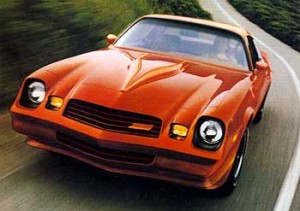



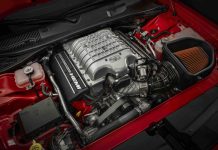




Hi;
Does anyone know where I can get a poster of a 1980 Black Camaro (Non-Z28)? Failing that a hi-res photo of a Z28 one that I could photo shop our the stripes. I’d like to get my top sales guy Tom a poster of his “first love”. Any help would be appreciated.
Trevor Leslie, President,
TJ Leslie Motors
Hi Trevor,
Have you tried this?
http://www.nastyz28.com/
I’m the guy doing the burnout in the 1980 Z28.
That Grey ’80 Z28 in the burnout box is my father’s car. I took that picture!
Hi Curtis,
I wish I had thought to take some pictures of me doing a burnout in my ’80 Z28!
Long gone, now… but, I still have my Trans-Am….
Just throwing a “lumpy cam”, headers and a holley on an otherwise stock 80-81 Z-28 may net you some gains (I think 300 hp is pushing the ragged edge), but it is not a good way to go.
The motor didn’t have enough static compression to support the larger camshaft and the poorly designed cylinder heads will choke off the motor’s abilty to rev. Basically you lose bottom end power and don’t gain much up top, but the car might sound badass.
Also have to slightly disagree with the blanket statement that modern cars are much more expensive to mod (not a fan of modern cars BTW, but I am a fan of some of the modern motors). It really depends upon the specific vehicle and what your goals are. FWIW I would say it is more correct to say that modern cars are much more expensive to tune. No more timing light and vacuum gauge for a recurve of the dizzy.
And why the focus on peak hp numbers? IMO they don’t mean much. For example, my 240hp V6 Buick (01 Regal GS) can edge out (by about half a car length) one of the new 300+hp V6 stangs in a drag race. Are my horses bigger? It’s not like I have a weight advantage. Most likely my car makes more average power than the Ford, even though peak hp is less.
I’ve been doing sportsman level drag racing since the mid 1980s…
so true about peak HP and usable HP….
Not sure if you mean rwhp or flywheel. 300 rwhp would have been pretty damned impressive indeed. With headers, full dual exhaust, and a Chevy 327/350hp cam my 1980 Z28 with the automatic was smooth as stock and ran 14.70s @ 93-mph. It would rev to 6000-rpm before power fell off noticeably. I usually shifted around 5800-rpm. The online calculator works that out to about 240rwhp which would be around 300 at the flywheel. It should have been delivered that way from the factory. With a set of 441 casting heads, Cam Dynamics 286 Enforcer cam, Edelbrock Performer intake and Holley 650 it was lumpy as hell at idle and ran 14.2s @ 98-mph. It had better bottom end than it did with the older 327/350-hp cam design and would pull strong until the valves floated at 6500 which was pushing it on a stock 2-bolt main bottom end anyway. I usually shifted around 6000-rpm. The online calculator says that was around 280rwhp or 350 at the flywheel. A single plane intake and Cam Dynamics 306 Enforcer cam matched to a 3500 stall torque converter would likely have put it over 300rwhp and into the 13s but at the expense of streetability. Not that it was particularly streetable as it was. Besides the lumpy cam I lowered it an inch all the way around by cutting the springs in front and sping mounts in back and fitted it with 265/15-15 T/A radials which required modifying the insides of the fenders for clearance and looked totally bad-ass but I had to avoid speed bumps. I also had it fitted with the thicker Trans Am WS6 anti-sway bars and adjustable gas shocks. Handling was great.
On nitrous it ran 13.70s @ 105-mph. Should have gotten better ETs on the nitrous but I couldn’t get it to hook up on street radials and it would just spin the tires all the way through second gear. While nothing special by today’s standards, at the time I had no trouble holding my own on the street. From 1980 – 1984 I rarely lost a race. The few cars that were faster were pretty obvious and easy to avoid and let’s be real, LS6 Chevelles, Boss 429 Mustangs (or even 428CJ Mustangs), Hemis and all of that ilk were no more common on the street then than ZL1 Camaros and Hellcats are today. Even less so given they would have been 10 years old by then and cars just didn’t last that long back then. Low 14s was enough to beat most anything that wasn’t a race car with licenses plates and my Z28 had the advantage of looking more or less stock. By 1985 the new Mustangs were giving me hell though. With the lighter weight, 5-speeds, and the roller cam, a setup similar to mine ran a good half second faster, sometimes better. I sold the Z28 later that year when I joined the Army.
Let me try that again – Once you know what to look for then you will to see it everywhere.
Only an anally retentive college trained bureaucrat-collie-dog would assume the sheep would never exceed the number he put on a dash gage. Same stupidity is on my 82 Honda Nighthawk. Nasty “warning red” at 55 MPH, stops at 85, but the bike will do 115+.
The later bow tie models were nice for plushness, but few memories rival winning the Saturday night stoplight drag races on Whittier Blvd. in a yellow and black ’69 Z-28 302.
Garysco , you were mentioning , “Only an anally retentive college trained bureaucrat”
Yeesh, I was just getting sucked (ered) into watching Duck Dynasty on DVD ( I liked a lot about them) and then I see that in season three they’re excited to go for a ride along with the cops and bust speeders.
I’d ignored the many subtle love of empire hints they dribbled on the show before this, but this was the cake.
It’s no wonder they named a lizard “Josey Wales” …are they perfect puppets, or what? … All of them. It’s so sick now that I see them for what they are. The Duck Dynasty duds are such Uber-Yuppies and empire loving s.o.b. sell outs. Makes me wanna puke.
I hope they all get fat and eat shit loads of wheat.
I regret trying to help them.
…And it only took one hour. Plus a day or two.
Crap! All this hype about the show and I’m turned on and tuned out in a flash.
It’s like they are Yankees in disguise or something?
I’m embarrassed to have fallen for those anally retentive college trained s.o.b.s.
Oh, but wait, this was a review on Z-28’s – a way cool car I’ve raced, and crashed.
So, never-mind, it doesn’t matter anyway.
Besides, [Insert song, I E-A-T Z-28, Trans-Am] here, X.
@helot – Yup, it’s all inside the Matrix. It is always hiding in plain sight. Once you know what to look then you will to see it.
Also, Re “never exceed the number he put on a dash gage.”
Ha! Is that Red Line? [ … I couldn’t find the link to the song.]
Me and my friends, we found that many times, and then some.
Such joy.
Hey Gary,
I didn’t know you had an ’82 Nighthawk! A long time ago, I had an ’83 CB550 (a DOHC four, for those not familiar with these bikes).. had a lot of good times on that one. It had a 135 MPH speedo – like my current ’83 GL650. But my friend’s ’82 GL500 has the 85 MPH clock.
Ridiculous!
@Eric – Ya, an ’82 CB650SC. A single cam bike Honda made from leftover 70’s parts in the wherehouse by the look of it. 83 and above went to newer tech, but I just like the look of the ’82 as a one-off year machine. Total looser on the $$$ side, but it is now torn apart and getting a complete restoration and custom paint. Those old GL650 & 500’s were unloved but very worthy machines.
I have a bunch of pictures of the ’83 CB550 … might do a reminisce piece about it. The bike was all kinds of fun for a young (and poor) guy back in the ’90s. I picked it up with low miles and hardly used for $1,500. Rode it like you would a jail-bait hard body and it never protested, never let me down. Always got great gas mileage – and though not a fierce bike, the little four would spin to more than 10,000 RPM and if you had the room and the nerve, around 120 on top.
One of my favorite bikes!
These cars were among the best of their time straight off the assembly line…and even better with a few “driver-installed” mods. After opening up that hood scoop, throw in a nice lumpy cam, maybe an Edelbrock or Offy intake topped with a Holley double pumper, ditch that cat in the middle for a test pipe or better yet, add a true dual exhaust with headers (if you didn’t live in the People’s Republic of California or similar neo-communist locale), and a hotter ignition, and you could easily get up to 300 streetable ponies with a few Ben Franklins and a few weekends of wrench-turning.
Those were the days…
Hi Bryce,
Yes, they were – I know, because I lived ’em!
Those late-70s Camaros (and Firebirds) had so much easily (and affordably) accessible power – it was a big part of what made them so much fun.
Installing headers, for instance, on an ’80 Z was doable with an afternoon of free time, some basic hand tools and some determination. Again, I know – because I did this mod.
Merely installing headers and a full dual system, jetting the carb and tuning the ignition could really wake up an otherwise stock ’77-81 Z28 (or 350 Camaro). If the car had a four speed and decent rear gears, you’d have yourself a 14 second car – and a whole lot of fun.
Add a cam – again, fairly easy and fairly cheap, doable by anyone with basic mechanical aptitude, a decent set of tools and some patience – and you could get 300-plus honest hp out of the thing – and be running solidly in the 13s.
Modern performance cars are much quicker as delivered – in factory stock trim. But they’re much harder (and a lot more expensive) to make quicker.
And – as I see it – there’s a lot more satisfaction to be had in driving a car you improved as opposed to a stocker that’s just like all the the others, that cost a fortune to buy – and which you’re afraid to do more than try an oil change on because it’s too elaborate or requires elaborate tools you can’t afford.
Eric, you should try following a current generation Camaro forum, people are still modifying cars cheaply.
There’s what is known as a ‘free’ mod which is just to reprogram the engine computer more aggressively. Sure some kids destroy engines this way but they did so back in the day too with modifications. Now if something goes wrong in this process of reprogramming the computer the car can end up a brick. Sometimes this requires dealer intervention to fix.
free is in quotes because one still has to buy the device to connect to car’s computer and of course the tune itself unless they want to make it themselves.
There are also various cheap intake and exhaust mods, which also require a ‘tune’ for them to work correctly, except for exhaust downstream of the cats of course.
Yes, absolutely.
But a new SS starts at $33k.
A 1980 Z28 stickered for about $7,100 (see here: http://www.hemmings.com/mus/stories/2005/05/01/hmn_feature19.html ) which is about $20k in 2014 dollars (see here: http://www.bls.gov/data/inflation_calculator.htm ).
In other words, a Z28 cost less – several thousand less – than a base V-6 new Camaro, and about $10k less than a new SS.
Plus, the insurance on the SS today is a huge peripheral costs, as is the property tax (calculated on the book/retail value – so hundreds annually for several years on a car with value over $30k).
Hence the Camaros being bought and tuned today are being bought by much older guys (typical buyer is over 40).
Back in the day, guys in their young and mid 20s could afford a Z28 – and afford to hop it up. Today it is – mostly – a graybeard indulgence.
Not all states property tax cars.
The forums have numerous 20somethings and teens. One of the reasons I infrequently follow the mustang forums. It’s often too juvenile. Some have more adults some have more teenagers. It depends.
Also as always, many buy used. I’ve helped a fair number of teenagers with their sort-it-out questions on SN95s.
As always, ove the Retro Reviews! PS: if you’re ever planning a Retro Review of the 1969-75 Chrysler Imperials, I’d be glad to write it up.
Gotta be the next best thing to driving an aircraft carrier down the street.